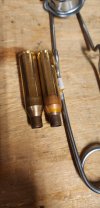eod.mickelson
Well-Known Member
Just picked up an ugly annealer, and am learning how to anneal brass. I did two test batches of cheap Hornady 6.5 creedmoor and it all went perfectly. I loaded up my 300 Norma Lapua brass and set it up the same way, lights off, flame pointed right where it's supposed to be, and first 20 rounds went perfectly. Then I started seeing a green flame on pieces every once and a while. Those pieces came out with a yellow ring (see picture). After that about 1/3 we're the yellow ring and 2/3 we're fine looking. Any ideas what caused it and if these pieces are torched? Thank you for any inputs.

